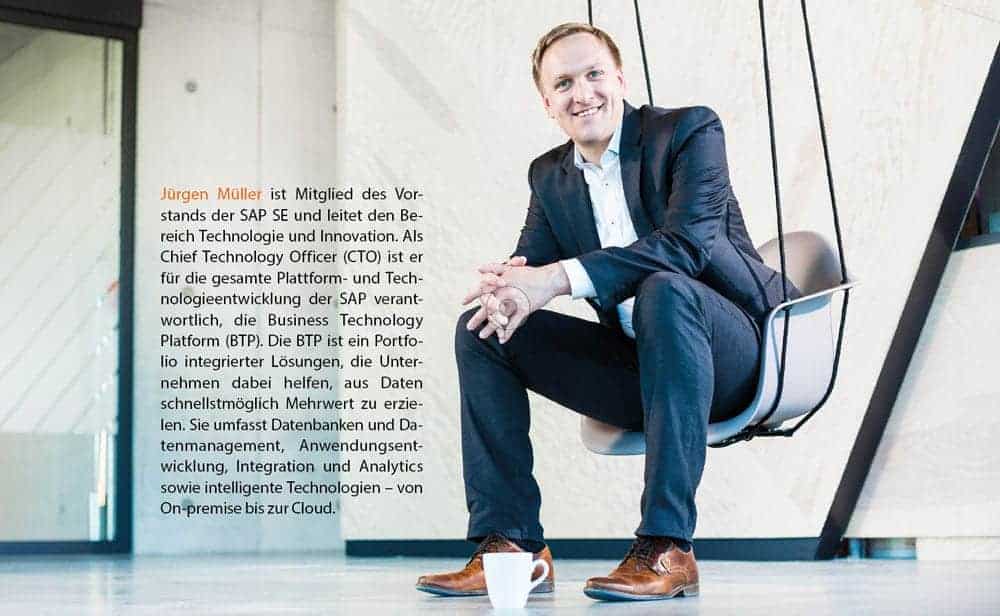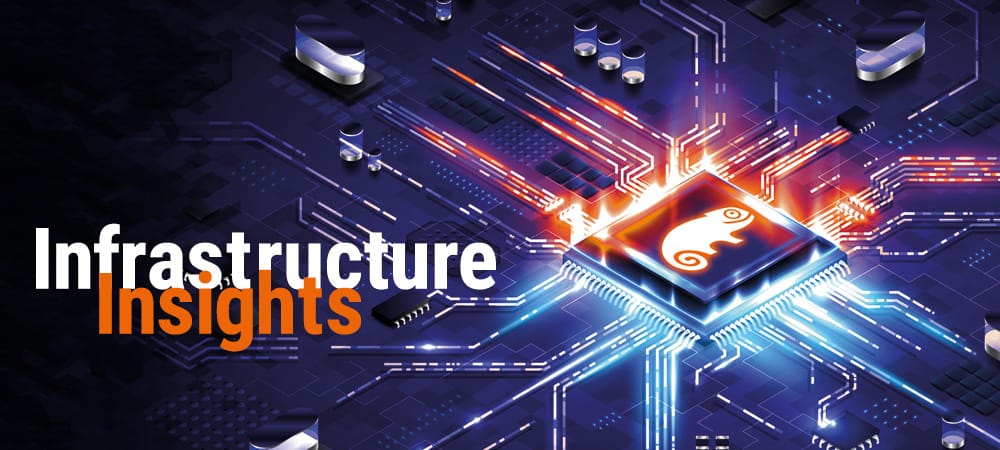The CTO transformation
![[shutterstock.com: 722159359, Maxx-Studio]](https://e3mag.com/wp-content/uploads/2020/10/shutterstock_722159359.jpg)

Strictly speaking, it is a double transformation - a technical and an organizational one. SAP itself and the community are on a journey across all technology topics. The old is to be preserved, the new is to grow. CTO Müller is to orchestrate it. Jürgen Müller has a degree in business informatics from the University of Göttingen and spent some time in China during his studies.
He also completed his doctorate in the field of new applications optimized for in-memory databases at the Hasso Plattner Institute in Potsdam. Since March 2019, Müller has been a member of the Senate of Acatech, the German Academy of Science and Engineering. His other activities include membership of the Supervisory Board of the German Research Center for Artificial Intelligence (DFKI).
Müller is highly respected and recognized in the technical SAP community and among SAP mentors. Traditional SAP customers from the business sector are less familiar with him. Transformation work is still needed here. E-3 Magazine conducted a very technical interview with SAP CEO Jürgen Müller.
Microsoft's purchase of the GitHub platform for $7.5 billion about two years ago demonstrated the importance of open source communities for enterprise software companies today. How is SAP working with the open source community?
Jürgen Müller: GitHub is the leading platform that SAP also uses intensively for its open source projects, for example, with the SAP Repositories. In 2019, the Open Source Contributor Index listed SAP as the ninth largest commercial contributor on GitHub. In addition, we use other platforms such as GitLab and are actively involved in numerous open source foundations.
SAP is currently supporting the Eclipse Foundation's move to Europe, for example. However, the code-sharing platform alone does not make an open source project or community successful. Rather, you have to invest time and effort in expanding and maintaining relationships and partnerships, which we actively and sustainably strive to do: We present our open source projects at conferences, events, meetups, and webinars.
We write detailed documentation and sample applications for our projects to make it easier for interested parties to participate. Furthermore, we exchange with the community in forums, such as Slack, and communicate news via blogs, social media or openSAP courses.
And what is the significance of these courses?
Muller: The numbers speak for themselves: Every year, we are pleased to see increasing contributions from external and internal contributors to our SAP open source projects. Especially for our cloud-native open source projects such as Kyma and Gardener, we have been able to win many new companies as development partners.
Last but not least, the Corona warning app, which was developed in open source, has clearly shown how decisive good cooperation with the community is for success and acceptance. (Editor's note: Kyma is a platform for extending applications with serverless functions and microservices. It provides a selection of cloud-native projects glued together to simplify the creation and management of extensions. Gardener deliver fully-managed clusters at scale everywhere with own Kubernetes-as-a-Service).

What is the current status of SAP Data Hub and SAP Data Intelligence and how can open source products be integrated?
Muller: SAP delivered the first version of SAP Data Hub in fall 2017. SAP Data Hub aims to provide a holistic solution for data integration, orchestration and management across distributed system landscapes. It also allows the associated creation and processing of data-driven applications. SAP Data Hub also enables data exchange with open source products, such as Kafka, and can immediately add value to existing landscapes when connected.
This can't be the end of the line, can it?
Muller: The next major step of the software took place in spring 2020, with the release 3.0 of SAP Data Intelligence, which marks the evolution from SAP Data Hub to SAP Data Intelligence. Enhanced and new functionalities in the area of system connection, metadata management as well as the operationalization of machine learning underline the changed name.
SAP Data Hub installations will be upgraded to SAP Data Intelligence with all new functionality with Release 3.0. There are no additional costs for SAP Data Hub customers, and no migration is required. SAP Data Intelligence is of course also available as a cloud offering.
Let's talk about artificial intelligence and machine learning: On which framework does SAP develop AI/ML applications?
Muller: Although our focus is on software, in the AI field we rely on specialized hardware, such as that from Nvidia. Especially in deep learning, when it comes to training unstructured data and complex AI models, Nvidia GPUs often offer excellent acceleration over CPUs. On the software side, our strategy is an open one.
This means that, in addition to open source, we also use our own developments and the frameworks offered by partners such as Nvidia. Especially in the open source environment, TensorFlow in combination with Python has proven itself and is equally appreciated by our data science teams.
And where does Leonardo stand?
Muller: Yes, a few more sentences on SAP Leonardo, since we are talking about smart technologies. We have retired SAP Leonardo as a standalone brand this year. Our intention when we launched it in 2017 was to introduce smart technologies like AI, blockchain, IoT to our customers and anchor them in our portfolio. We have successfully mastered exactly that. With over 250 use cases, "smart technologies" are an integral part of our Intelligent Enterprise strategy.
To an outsider, it gives the impression that Mercedes, for example, is much more innovative in its cooperation with Nvidia than many traditional IT houses such as SAP. Is this impression deceptive?
Muller: I think that perception is a bit misleading. Not least because many things are simply more tangible for B2C brands than for us as an enterprise provider. This year in particular, SAP was able to help quite directly with its innovative strength, speed and agility. When the State Department had to retrieve travelers stranded abroad at the beginning of the Corona pandemic in March of this year, SAP quickly helped with a retrieval app.
The app, based on SAP Cloud Platform, was programmed and published in less than 24 hours; more than 240,000 citizens were returned to Germany as part of the return campaign. As mentioned above, the Corona alert app project has also shown how innovative, agile and fast SAP, partners and experts from the community work together when it counts.
The community stands by SAP, and how is it beyond the ERP trough?
Muller: SAP is also perceived externally as an innovative company: As part of the annual Global Innovation Survey conducted by the Boston Consulting Group, SAP was again named one of the "Most Innovative Companies 2020" this year. In addition, SAP is on the "Fast Company Best Workplaces for Innovators" list this year.
The SAP Hana database platform was also announced as an open system beyond ERP. What has become of these initiatives?
Muller: Now in its tenth year, SAP Hana is being widely used by SAP customers and partners - including as an open system. Here are some examples of how users are using the SAP database: SAP and Esri, the world's leading provider of location intelligence solutions, have been working together for several years. With SAP Hana Service, we provide a database-as-a-service offering that can be used as the basis of the geodatabase for the ArcGIS platform.
But Hana is only growing as a database, right?
Muller: The number of SAP products based on Hana has continued to grow over the years. Today, the database forms the basis for numerous products and solutions in the portfolio, including SuccessFactors, SAP Customer Experience, and Ariba.
And concrete examples?
Muller: SuccessFactors has achieved a high of one billion cloud transactions per day since completing the migration to Hana. In SAP Customer Experience solutions, data import has been completed 65 times faster than with the previous databases. The Ariba team increased its overall cloud integrity score in all areas by 18 points, on an absolute 100-point scale, by moving to Hana.
SAP Analytics Cloud, for example, can connect to live data in Hana databases on your own network, Hana Enterprise Cloud, SAP Cloud Platform, and Cloud Foundry. SAP Data Warehouse Cloud, an end-to-end warehouse in the cloud that combines data management processes with advanced analytics, is also built on Hana.
Is this one-time or continuous?
Muller: As part of the annual SAP Innovation Award, SAP honors projects from customers and partners that, among other things, build applications on Hana. And of course, we want Hana to be used even more intensively outside of ERP applications. For example, we are currently working on an attractive offer for partners for SAP Hana Cloud.
SAP has not only been very successful in recent years, but has also grown considerably - maintaining an overview here is no easy task: Is there a taxonomy of SAP technology and products?
Muller: At SAP, we have special functions and people responsible for terminology, taxonomy and naming. The so-called "One Voice" experts have been responsible for the naming strategy and concepts of SAP solutions, products, technologies and services since 2001.
Our staff and agency partners have access to the internal Naming Center repository, where the exact names of all current and retired products, solutions and services, as well as the names of organizations, events, programs and tools, can be viewed. The Naming Center also serves as a historical database of all approved terms. Partners can access an updated list of all approved and retired names at sappartneredge.com.
And for the normal SAP community member?
Muller: In addition, we have sapterm.com, an SAP terminology database accessible to everyone, which provides details and additional info on technologies. The entries are updated on a weekly basis. In SAP's annual Integrated Report, which is available online for anyone to view and download, we provide a glossary of the 250 most important terms related to SAP products, solutions, and technologies. The report and glossary are updated every year.
SAP and Intel have been working together for many years. Last year, both companies announced that SAP Hana and Intel Optane DC Persistent Memory are a very good match. What are the use cases and proof points?
Muller: SAP Hana is, in fact, the heart of SAP. With Hana, companies across all industries can fully realize the potential of data and in-memory information processing by gaining complete visibility and insight into their business operations in real time. Last year, we were able to optimize Hana as the first major database to support Intel Optane DC Persistent Memory.
This enables enterprises to further increase application availability while reducing total cost of ownership. The cost-saving data tiering, native memory expansion, NSA, and support for the new persistent Intel Optane DC memory modules contribute precisely to this.
Does this also have practical significance?
Muller: Yes, here are a few examples of how customers are benefiting: Swiss sanitary products company Geberit evaluated Intel persistent storage technology with two of its existing Hana systems and found a 4.2-fold improvement in system startup data load times for a 1.5-terabyte Hana database, or more than 400 percent.
The combination of Hana and Intel Optane DC Persistent Memory has enabled German chemical company Evonik Industries to reduce its startup times by 17 times, a major step forward for business continuity.
How many codebases for Hana are there at SAP, and is consolidation ultimately planned here?
Muller: We currently have three lines of code for Hana and Hana Cloud that are in maintenance and development, respectively: Hana 1.0, Hana 2.0 and Hana Cloud. Hana 1.0 SPS12 will go out of maintenance next year. The developments for Hana Cloud will also be selectively ported to the Hana 2.0 code line and thus made available to our on-premises customers. This is possible because Hana 2.0 and Hana Cloud are based on the same code line in the core elements.
How long will SAP NetWeaver continue to be developed? And what is the current status of Abap and Java?
Muller: The SAP NetWeaver technology platform is under maintenance. Release 7.5 will be maintained in mainstream maintenance until the end of 2027, then optionally in extended maintenance until the end of 2030. The Abap technology is being intensively developed for SAP S/4 Hana and SAP Cloud Platform under the project name "Steampunk".
Our customers, partners and all interested parties can follow the progress and news continuously in various blogs from the SAP community itself. For the transition to Hana and Cloud, we offer Abap analysis and transformation tools. We also offer Java on the SAP Cloud Platform with Cloud Foundry and also Kyma with Kubernetes.
Thank you for the interview.






